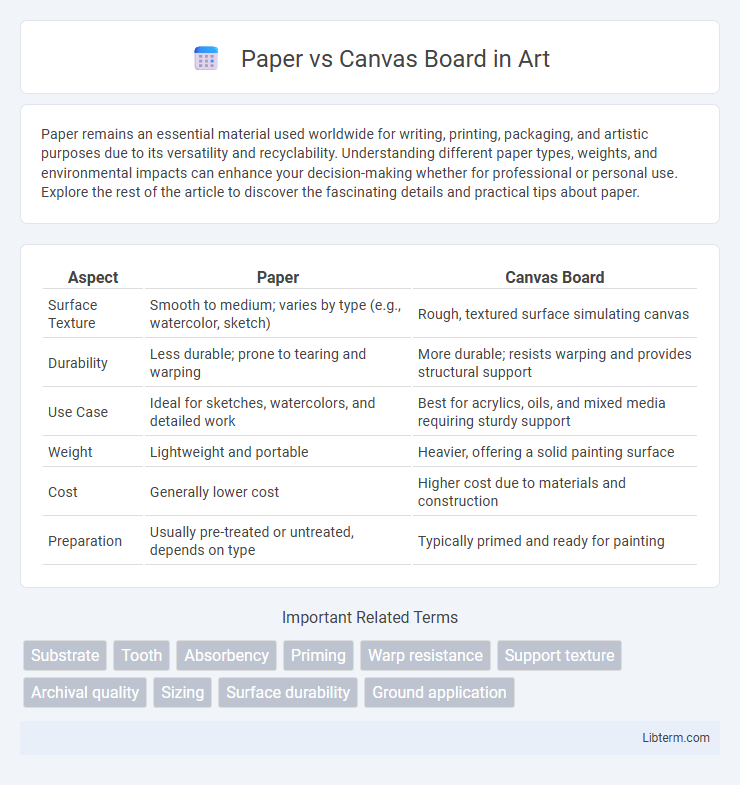Paper remains an essential material used worldwide for writing, printing, packaging, and artistic purposes due to its versatility and recyclability. Understanding different paper types, weights, and environmental impacts can enhance your decision-making whether for professional or personal use. Explore the rest of the article to discover the fascinating details and practical tips about paper.
Table of Comparison
| Aspect | Paper | Canvas Board |
|---|---|---|
| Surface Texture | Smooth to medium; varies by type (e.g., watercolor, sketch) | Rough, textured surface simulating canvas |
| Durability | Less durable; prone to tearing and warping | More durable; resists warping and provides structural support |
| Use Case | Ideal for sketches, watercolors, and detailed work | Best for acrylics, oils, and mixed media requiring sturdy support |
| Weight | Lightweight and portable | Heavier, offering a solid painting surface |
| Cost | Generally lower cost | Higher cost due to materials and construction |
| Preparation | Usually pre-treated or untreated, depends on type | Typically primed and ready for painting |
Introduction to Paper and Canvas Board
Paper and canvas board are both popular surfaces used for painting and drawing, each offering unique textures and durability. Paper, typically made from cellulose fibers, is lightweight and versatile, suitable for various media such as watercolor, charcoal, and ink. Canvas board combines a canvas-like surface adhered to a rigid board, providing a durable, textured foundation ideal for acrylic and oil painting.
Key Differences Between Paper and Canvas Board
Paper and canvas board differ primarily in texture, durability, and suitability for various art mediums. Paper is typically smoother, lightweight, and best suited for drawing, watercolor, or light acrylics, while canvas board offers a textured surface that mimics stretched canvas and is more durable for heavier acrylic or oil paints. The canvas board's rigid backing provides better support, reducing warping and enhancing longevity compared to most paper types.
Surface Texture and Feel
Canvas board features a textured surface that mimics the weave of traditional canvas, offering a tactile feel ideal for acrylic and oil painting techniques. Paper surfaces vary widely, from smooth to rough, with cold-pressed or hot-pressed options that influence paint absorption and brush movement. The choice between canvas board and paper greatly impacts the artwork's surface texture, affecting both visual detail and the physical interaction with the medium.
Durability and Longevity
Canvas board offers superior durability and longevity compared to paper due to its sturdy canvas surface adhered to a rigid board, resisting warping and tearing over time. Paper, especially thinner types, is more prone to damage from moisture, bending, and fading, making it less suitable for long-term preservation. Artists seeking lasting artworks often prefer canvas board for its resilience and archival qualities.
Suitability for Various Mediums
Paper offers excellent compatibility with dry mediums like graphite, charcoal, and colored pencils, providing a smooth and absorbent surface for detailed work. Canvas board excels with wet mediums such as acrylics and oils, its textured coating ensuring better paint adhesion and durability. Artists often choose paper for sketches and studies, while canvas board is preferred for finished paintings requiring longevity and vibrancy.
Portability and Ease of Use
Paper offers superior portability due to its lightweight and flexible nature, making it easy to carry in portfolios or sketchbooks. Canvas board, while still relatively portable, is thicker and less flexible, which can limit storage and transport options. Ease of use favors paper for quick sketches and studies, whereas canvas board provides a sturdy surface ideal for acrylic or oil painting, requiring less preparation.
Cost Comparison
Canvas board generally costs more than paper due to its thicker, textured surface and durability, making it suitable for longer-lasting artwork. Paper is more affordable and widely available, making it ideal for beginners or quick studies without the investment in premium materials. Bulk purchases of quality paper can further reduce expenses, while canvas board typically requires a higher upfront cost.
Preparation and Maintenance
Canvas board offers a sturdy surface that requires minimal preparation, often needing only a light application of gesso to create an ideal painting texture. Paper, especially watercolor or mixed media types, demands careful selection for thickness and sometimes pre-stretching or taping to prevent warping during use. Maintaining canvas board is simple, involving gentle cleaning and storage in a flat, dry environment, while paper needs protection from moisture and frequent flattening to preserve its integrity.
Artistic Outcomes and Effects
Canvas board offers a textured surface that enhances paint adhesion and creates rich, tactile effects ideal for acrylic and oil paintings, fostering depth and dimension in artwork. Paper provides a smoother, more controlled medium conducive to detailed work, watercolors, and mixed media, but may buckle or warp under heavy paint applications. Artists seeking durability and vibrant color retention often prefer canvas board, while those prioritizing fine details and portability lean towards high-quality paper.
Choosing the Right Surface for Your Artwork
Choosing the right surface for your artwork depends on the medium and desired texture; paper offers smoothness ideal for watercolors and detailed pencil work, while canvas board provides a sturdy, textured surface better suited for acrylics and oils. Paper is lightweight and portable, making it convenient for sketches and studies, whereas canvas board supports layered painting techniques and enhances color vibrancy. Understanding the strengths of each surface helps artists achieve the intended visual effect and durability in their creations.
Paper Infographic

 libterm.com
libterm.com